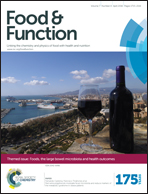Investigations of in vitro bioaccessibility from interesterified stearic and oleic acid-rich blends
Abstract
Interesterification was previously found to impact stearic acid absorption in a randomized cross-over study, when human volunteers consumed a 70 : 30 wt% high-oleic sunflower and canola stearin blend (NIE) compared to the same blend which had undergone either chemical (CIE) or enzymatic (EIE) interesterification. In this research, in vitro lipid digestion, bioaccessibility, and changes in undigested lipid composition and melting behavior of these same test fats were investigated using the dynamic, multi-compartmental TIM-1 digestion model and compared with the previous human study. Overall, TIM-1 bioaccessibility was higher with interesterification (p < 0.05). Oleic acid bioaccessibility was higher than stearic acid bioaccessibility for NIE, and vice versa for the interesterified blends (p < 0.05). Stearic acid was more concentrated in the undigested triacylglycerols (TAG) from NIE, corresponding to a relatively higher melting temperature of the undigested lipids. The results confirm the impact of TAG composition, fatty acid position and/or physical properties on lipid digestion. TIM-1 bioaccessibility was linearly correlated (R2 = 0.8640) with postprandial serum TAG concentration in the human study. Therefore, the in vitro digestion model offered predictive insights related to the impacts of lipid interesterificaton on absorption.


 Please wait while we load your content...
Please wait while we load your content...